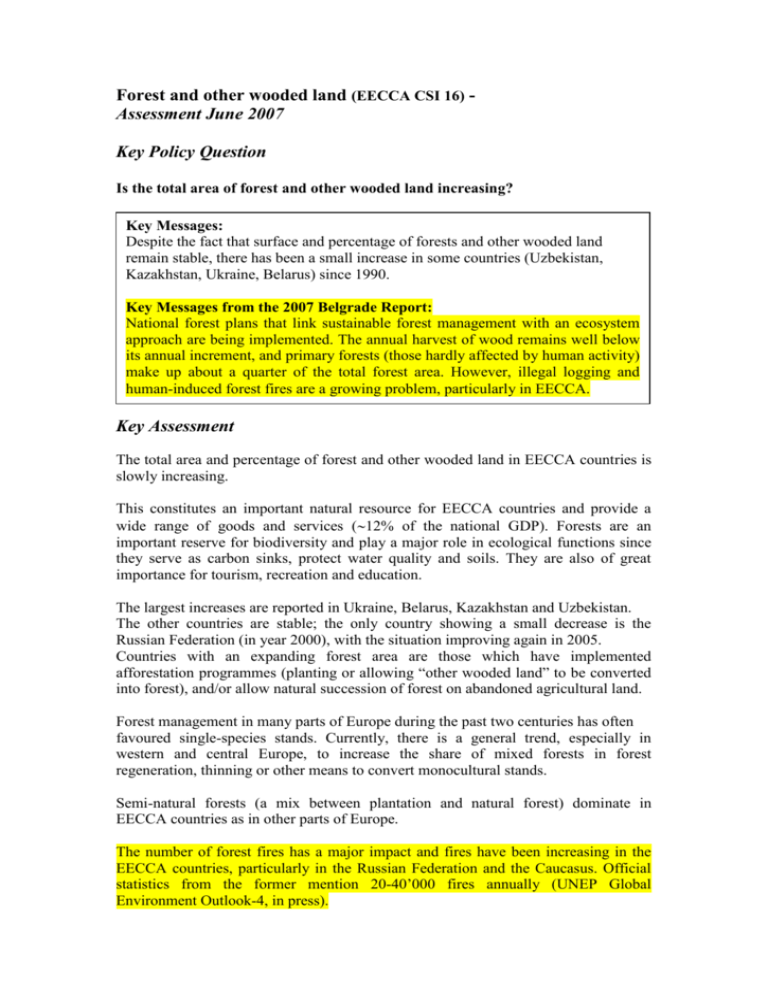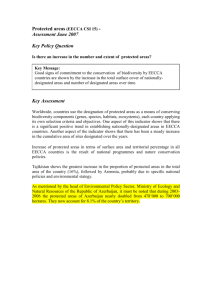Consumption of ozone-depleting substances (EECCA CSI
advertisement

Forest and other wooded land (EECCA CSI 16) Assessment June 2007 Key Policy Question Is the total area of forest and other wooded land increasing? Key Messages: Despite the fact that surface and percentage of forests and other wooded land remain stable, there has been a small increase in some countries (Uzbekistan, Kazakhstan, Ukraine, Belarus) since 1990. Key Messages from the 2007 Belgrade Report: National forest plans that link sustainable forest management with an ecosystem approach are being implemented. The annual harvest of wood remains well below its annual increment, and primary forests (those hardly affected by human activity) make up about a quarter of the total forest area. However, illegal logging and human-induced forest fires are a growing problem, particularly in EECCA. Key Assessment The total area and percentage of forest and other wooded land in EECCA countries is slowly increasing. This constitutes an important natural resource for EECCA countries and provide a wide range of goods and services (12% of the national GDP). Forests are an important reserve for biodiversity and play a major role in ecological functions since they serve as carbon sinks, protect water quality and soils. They are also of great importance for tourism, recreation and education. The largest increases are reported in Ukraine, Belarus, Kazakhstan and Uzbekistan. The other countries are stable; the only country showing a small decrease is the Russian Federation (in year 2000), with the situation improving again in 2005. Countries with an expanding forest area are those which have implemented afforestation programmes (planting or allowing “other wooded land” to be converted into forest), and/or allow natural succession of forest on abandoned agricultural land. Forest management in many parts of Europe during the past two centuries has often favoured single-species stands. Currently, there is a general trend, especially in western and central Europe, to increase the share of mixed forests in forest regeneration, thinning or other means to convert monocultural stands. Semi-natural forests (a mix between plantation and natural forest) dominate in EECCA countries as in other parts of Europe. The number of forest fires has a major impact and fires have been increasing in the EECCA countries, particularly in the Russian Federation and the Caucasus. Official statistics from the former mention 20-40’000 fires annually (UNEP Global Environment Outlook-4, in press). In general, the data available for forest and other wooded land in the EECCA region indicate that surface and percentage of forests and other wooded land remain stable. Policy statements and the goal of increasing forest extent, as found in the EECCA Environment Strategy (EAP Task Force Secretariat , OECD, www.eecca.net) are not likely to be met if this trend remains stable. Countries and the international community will need to make significant efforts to improve the system for protection of forests from overlogging, illegal cutting and forest fires. Technical assistance and the introduction of new market-based management arrangements are needed to ensure environmentally sustainable development of the forestry sector, and restore the system of regular forest management. Methodology and references How did we create this indicator? See UNECE Guidelines for the Application of Environmental Indicators in Eastern Europe, Caucasus and Central Asia for methodology, rationale and more relevant details about this indicator. http://www.unece.org/env/europe/monitoring/7thmeeting/Indicator%20Guidelines%2 0%20Consolidated.En.pdf Time period: 1990/2000/2005 Units: km2 and percentage for share of forests and wooded land. Data source: FAOStat, http://faostat.fao.org/default.aspx Other recommendations From Belgrade Report: A wide range of products is obtained in the European forest; most importantly industrial round wood. Wood removals in NW Europe are with 440 million cubic metre more than double as high as in Eastern Europe. In the SEE countries about 64 million cubic metres are harvested, and in the Caucasian and Central Asian countries it is much less. According to the data that were available from UNECE/FAO (2005), the amount of industrial roundwood harvested has increased since 1990 in NW Europe, Caucasus and Central Asia, whereas it has decreased to its half in Eastern Europe due to the crisis of the Russian forestry sector. In the SEE region the amount of industrial round wood has been quite stable. Especially for countries in the Caucasus, Central Asia, on the Balkan and also for Turkey, wood fuel remains of great importance for the rural population (despite a fuelwood harvesting decline in Turkey). However, the importance of wood fuel has been increasing also in NWE. This is in line with the EU policy target of increasing the share of renewable energy in energy production. The fuel wood amount in Eastern Europe had decreased between 1990 and 2000, but has increased again during the last 5 years. Regional differences on the importance of woodfuel harvesting in European regions are shown in Figure . (UNECE/FAO, 2005) From UNECE’s EPRs: Ukraine (2006, second review), "Land management and protection" at http://www.unece.org/env/epr/studies/Ukraine_2/chapter10.pdf Belarus (2005, second review), “Environmental management in agriculture and forestry” at http://www.unece.org/env/epr/studies/belarus/Chapter7.pdf Moldova (2005, second review), “Environmental management in agriculture and forestry” at http://www.unece.org/env/epr/studies/moldova_2/chapter07.pdf Tajikistan (2004), “Biodiversity and forest management” at http://www.unece.org/env/epr/studies/Tajikistan/chapter09.pdf Azerbaijan (2003), “Biodiversity and forest management” at http://www.unece.org/env/epr/studies/azerbaijan/Chapter09.pdf Georgia (2003), “Biodiversity and forest management” at http://www.unece.org/env/epr/studies/georgia/chapter08.pdf Uzbekistan (2001), “Biodiversity management” at http://www.unece.org/env/epr/studies/uzbekistan/chapter08.pdf Armenia (2000), “Forests” at http://www.unece.org/env/epr/studies/armenia/chapter05.pdf Kazakhstan (2000), “Biodiversity & forests” at http://www.unece.org/env/epr/studies/kazakhstan/chapter10.pdf Kyrgyzstan (2000), “Biodiversity & forests” at http://www.unece.org/env/epr/studies/kyrgyzstan/chapter08.pdf







